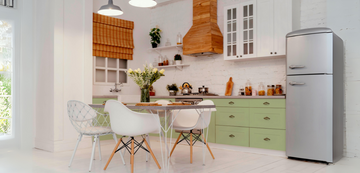Trending Cost-Effective Modular Kitchen Designs: Multiple Shapes and Styles
by Pankaj Singh on Feb 12, 2024

Among the latest trends in home design, modular kitchens have taken a prominent spot, offering both style and functionality. If you're searching for a modular kitchen that aligns with your financial plan and stylish preferences, this complete guide is for you.
What is a Modular Kitchen?
A modular kitchen is a modern and flexible method for planning your kitchen, allowing you to pick various pre-made cupboards (modules) in multiple sizes and styles. These modules can be easily assembled and disassembled, making them a convenient and popular choice. They are designed to maximize utility and space efficiency while minimizing the cost.
Modular Kitchen Designs and Shapes
Modular kitchens come in various designs and shapes. The most common configurations are:
L-shaped: Ideal for small to medium-sized kitchens, this design optimizes corner space.

U-shaped: It best suits larger kitchens and provides ample storage and counter space.

Straight or One-wall: Perfect for tiny spaces, this layout aligns everything along one wall.

Island and Peninsula: These variations add additional counters or dining space in larger kitchens.
Choosing the Right Units
When selecting the units for your modular kitchen, consider the following:
- Functionality: Consider how each unit will be used. For example, opt for deep drawers with soft-close mechanisms for pots and pans, while pull-out trays are great for storing spices and condiments.
- Cabinet Style: Modular kitchens come in various cabinet styles, from traditional to modern. Choose the design which matches the aesthetics of your home.
- Colour and Finish: The variety and finish of your kitchen units can affect the look and feel of your kitchen. Decide whether you prefer a classic wood finish, sleek high-gloss surfaces, or something.
- Hardware and Accessories: Watch out for the quality of equipment, like handles, knobs, and hinges. High-quality hardware ensures smooth operation and durability. Additionally, consider accessories like pull-out trash bins, cutlery organizers, and built-in dividers for more efficient storage.
- Material Selection: Modular kitchen units are available in various materials, including wood, MDF (Medium-Density Fiberboard), particleboard, and metal. Each material has benefits and disservices for sturdiness, cost, and feel. Make a decision based on your taste and financial plan.
- Open Shelving vs. Closed Cabinets: Decide whether you want open shelving for displaying dishes and cookware or closed cabinets for a cleaner, more organized look. Open shelving can add a touch of style and accessibility to your kitchen.
- Corner Solutions: Corners can be challenging to access in L-shaped or U-shaped kitchens. Consider using specialized corner units like carousels or pull-out shelves to make the most of these spaces.
- Custom vs. Standard Sizes: Custom-sized units offer precise fitment but can be more expensive. Standard-sized units are readily available and more budget-friendly. Carefully assess your kitchen's layout to determine which option suits you best.
- Maintenance and Cleaning: Some materials and finishes are easier to clean and maintain than others. Consider your cleaning preferences.
Kitchen Maintenance Tips
Maintaining a modular kitchen is crucial for its longevity. Use mild detergents for cleaning surfaces and avoid harsh chemicals. Regularly check and tighten hardware, and keep the kitchen well-ventilated to prevent moisture buildup.
Budgeting and Cost Effectiveness
One of the most significant advantages of modular kitchens is their cost-effectiveness. The price varies based on materials, designs, and accessories, so setting a budget beforehand is essential. Prefabricated units are generally more affordable than custom-made ones. Investing in good-quality materials can save maintenance costs in the long run.
Technical Aspects
Consider the technical aspects like plumbing, electrical, and ventilation systems. Ensure that the design accommodates these necessities efficiently.
Accessories and Add-Ons
Accessories can significantly enhance the functionality of your kitchen. Options include pull-out baskets, corner units, under-sink accessories, and more. Choose according to your cooking habits and space availability.
Saving Money
To save on installation costs:
- Plan your kitchen layout well in advance.
- Stick to standard sizes and finishes, as customizations can increase the price.
- Look out for deals and offers from manufacturers.
Wrapping Up
A modular kitchen is not simply a buy; it's an interest in your home and way of life. With the proper preparation and decisions, you can have a kitchen that is both effective and a joy to cook in. Whether you are a novice cook or a culinary expert, the perfect modular kitchen awaits to complement your skills and elevate your home's aesthetic.






